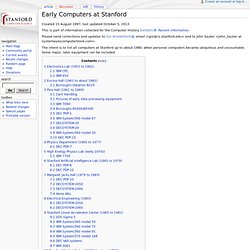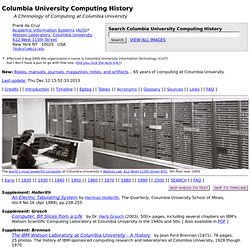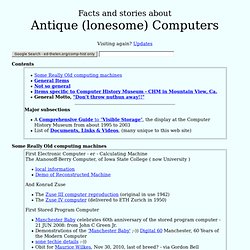

The DigiBarn Open House. Decode Systems. The DigiBarn Computer Museum. Bitsavers.org. Bitsavers.org. Bitsavers.org. Bitsavers.org. Early Computers at Stanford - Stanford CSD History. From Stanford CSD History Created 15 August 1997, last updated October 5, 2013.

This is part of information collected for the Computer History Exhibits. Recent information. Please send corrections and updates to Gio Wiederhold, email <gio@cs.stanford.edu> and to John Sauter <John_Sauter at systemeyescomputerstore.com>. The intent is to list all computers at Stanford up to about 1980, when personal computers became ubiquitous and uncountable. Electronics Lab (1953 to 1962) In March of 1953 an IBM CPC arrived at the Electronics Lab. Although it provided some storage, the IBM CPC was not a stored-program computer in the modern sense. The data paths between storage units in the accounting machine and the auxiliary storage units were determined by wiring. The IBM CPC was normally configured to do floating-point calculations. There was also an IBM CPC at Cornell. In addition, Les Earnest used one from 1954 to 1956 in the Navy at the Aeronautical Computer lab in suburban Philadelphia, PA.
Computer History Exhibits. Computing at Columbia Timeline. Columbia University Computing History A Chronology of Computing at Columbia University New:Books, manuals, journals, magazines, notes, and artifacts... 65 years of computing at Columbia University.

Last update: Thu Dec 12 15:52:33 2013 [ Credits ] [ Introduction ] [ Timeline ] [ Epilog ] [ Tables ] [ Acronyms ] [ Glossary ] [ Sources ] [ Links ] [ FAQ ] The world's most powerful computer at Columbia University's Watson Lab, 612 West 115th Street NYC, 5th floor rear, 1954. [ Early ] [ 1920 ] [ 1930 ] [ 1940 ] [ 1950 ] [ 1960 ] [ 1970 ] [ 1980 ] [ 1990 ] [ 2000 ] [ SEARCH ] [ FAQ ] Supplement: Hollerith An Electric Tabulating System by Herman Hollerith, The Quarterly, Columbia University School of Mines, Vol.X No.16 (Apr 1889), pp.238-255.
Supplement: Grosch Computer: Bit Slices from a Life by Dr. Supplement: Brennan The IBM Watson Laboratory at Columbia University - A History by Jean Ford Brennan (1971). 76 pages, 25 photos. Supplement: Hankam. Antique Computers - Ed Thelen. From: L Roth To: IBM 604 Sent: Sunday, February 07, 2010 Subject: hello, 604 units Hello Ed, Very interseting site on the IBM 604.

I graduated from an electronics school in Mpls in 1960. Our instruction back than on computers consisted of flip-flop circuits to learn basics. An interesting project was the Overbeck ring and an "electronic roulette wheel" using the 2-xxxx triggers - flip-flops. After I graduated from tech school I ended up in Seattle,WA. And a response from Robert Garner L Roth, The history of computing project. History of the Internet. First publication of the original ARPANET Host-Host protocol: C.S. Carr, S. Crocker, V.G. Cerf, "HOST-HOST Communication Protocol in the ARPA Network," in AFIPS Proceedings of SJCC (:vgc:) First report on ARPANET at AFIPS: "Computer Network Development to Achieve Resource Sharing" (March) ALOHAnet, the first packet radio network, developed by Norman Abramson, Univ of Hawaii, becomes operational (July) connected to the ARPANET in 1972 ARPANET hosts start using Network Control Protocol (NCP), first host-to-host protocol First cross-country link installed by AT&T between UCLA and BBN at 56kbps. 15 nodes (23 hosts): UCLA, SRI, UCSB, Univ of Utah, BBN, MIT, RAND, SDC, Harvard, Lincoln Lab, Stanford, UIU(C), CWRU, CMU, NASA/Ames BBN starts building IMPs using the cheaper Honeywell 316.
Ray Tomlinson of BBN invents the email program to send messages across a distributed network.
Computer History Museum. Gordon Bell's Publications.